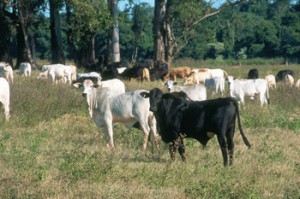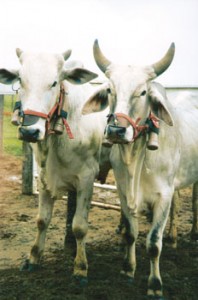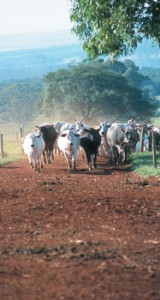
EDUARDO CESARA greater variety of forage plants and combination with plantations can help cut methane emissions EDUARDO CESAR
Well kept pastures, as well as nourishing animals, can work as a good absorber of carbon dioxide (CO2), the main gas accused of causing the planet’s greenhouse effect. Taking better care of how cattle are fed also reduces the emissions of methane (CH4) into the atmosphere. The problem – which at first may seem like a joke for those that are unfamiliar with the subject – concerns cattle eructation, i.e., their belching. Methane is very bad for global warming because, along with CO2 and nitrous oxide (N2O), it keeps the heat from the sun escaping from the Earth’s surface and from the lower layers of the atmosphere. These gases, plus the natural vapor generated by the oceans, form a molecular barrier that, if it becomes too thick, keeps heat from dissipating into the higher levels of the atmosphere. “A pasture that is well cared for captures the carbon dioxide (CO2)”, says agronomical engineer Odo Primavesi, coordinator of the technical team that first measured Brazilian cattle’s methane emissions in the field and who studied animal feed and pastures up until his recent retirement from Embrapa (Southeast Livestock Farming unit), in the town of São Carlos, inner-state São Paulo.
Brazil’s pastures account for more than 60% of its farming area. Slash burning accounts for the largest portion of CO2 emissions and are connected with the agricultural frontier’s encroachment on native woodlands, primarily to form new pastures. These emissions also result from the burning of organic residues and vegetable waste from farmed land, in order to “clean” the terrain. As for methane, the chief source is cattle farming, with the largest commercial cattle herd in the world, totaling about 180 head. Other farm animals account for only 3.2% of the total. If the CO2 issue centers on slash burning, the methane issue is linked to the digestive process of ruminant herbivores, such as cattle, buffaloes, sheep, goats and camels. It results from the so-called enteric fermentation in the rumen, the first stomach, when the ingested greenery is metabolized by a population of anaerobic microorganisms and that include bacteria, fungi and protozoa. Estimates indicate that eight million tons of methane are released by cattle in Brazil per year, i.e., 10% of the rumen methane of the world and to 3% of the total produced by human activity. As compared to CO2, methane is 25 times more powerful when it comes to retaining heat in the atmosphere, though a lower amount of it is released worldwide.
Primavesi collaborated with a broad study on the quantification of methane emissions caused by crop and livestock farming, to be published by Embrapa by the middle of this year. “Estoques de carbono e gases de efeito estufa em sistemas agropecuários e florestais” [Stocks of carbon and greenhouse gases in forest, crop and livestock farming systems] is the name of the study. It will probably be the book’s title as well. In this article, Primavesi, along with researchers Magda de Lima and Rosa Shiraishi Frighetto, from Embrapa Meio Ambiente, and João José Demarchi and Alexandre Berndt, from the Pastures and Animal Nutrition R&D Center at the Zootechnology Institute of the Bureau of Agriculture and Supplies of the State of São Paulo, estimated cattle methane emissions and suggested possible solutions for the problem. They recommend, among other alternatives, crop and livestock farming integration, by rotating plantations and pastures, which helps to form better fields, plus the addition to feed of supplements such as yeasts, straw-less sugarcane and a combination of forage plants, such as grasses, and legumes with a higher protein content, as the latter can minimize methane emissions by providing improved rumination efficiency.

Embrapa Meio AmbienteThe methane measuring equipment is attached to the muzzle and neck for 24 hoursEmbrapa Meio Ambiente
Gas bill
Emissions from eructation, besides enhancing global warming, cause a loss of energy and therefore a drop in beef or milk production. “Under normal circumstances, when there is a good supply of feed and water, an ox emits, over 26 months, some 73 kg of methane, or 445 grams of methane per kilogram of meat”, says Primavesi. “However, on a poor pasture with over-grazing, meaning overuse without pasture recovery or preservation efforts, on which the animal gets hungry and becomes ready for slaughter in 42 months, an ox can emit 115 kg of methane or more, meaning 736 grams per kilogram of meat”. To measure cattle methane emissions, Primavesi coordinated the Brazilian adaptation of a system developed at the University of Washington in the 1990’s. This was based on sulfur hexafluoride (SF6), a gas packaged into a small capsule inserted in the animal’s rumen. The capsule releases the gas through a Teflon and porous steel membrane at the rate of 1 thousand to 2 thousand nanograms a minute, which simulates the pattern of methane emissions and works as a marker. Through a very fine tube connected to the animal’s halter and installed near its nose and mouth, the gases are collected in a closed tube made of stiff plastic, attached around the ox’s neck for a 24-hour period. Kept under vacuum, the tube is then transferred to a lab where a chromatograph measures the methane and SF6 concentration.
“Significant methane emissions can account for a loss of energy of as much as 18%, which is what happens with poor quality forage and with low protein content”, says Primavesi. Energy that is not transformed into beef, when the animals are being reared for meat and that will require that the animal spend more time grazing in order to reach its slaughter weight of some 450 kg, resulting in further emissions by a single animal. “The ideal thing would be for the animal to spend only 24 months grazing”, says Primavesi. “Feeding deficiencies, in particular during the dry time of the year, can cause the ox to lose weight, like 15 kg, for example. This is mass that it will have to recover, producing methane yet again in order of yield the same kilogram of beef”. Some of the solutions to keep cattle from losing weight are simple, such as good feed supplements during the dry season, if the forage is insufficient, and keeping the cattle from having to walk far for their feed and their water.
“There are also strategies to improve the efficiency of cattle digestion by properly balancing their feed and adopting yeasts such as Saccharomyces cerevisiae“, João Demarchi exemplifies. One of the additives that can reduce methane production is antibiotic products, which inhibit some of the undesirable rumen microorganisms, such as methanogenic bacteria and protozoa. Another factor mentioned by the researchers is integration with agriculture. “Half of the pastures could be improved and the integration of crop and livestock farming and forest husbandry is a good solution, involving reforesting some areas, planting brachiaria grasses (the main plant used in Brazil’s pastures) and, for instance, beans, soy or forage legumes that can recover the pasture’s soil, in addition to adopting direct planting systems whereby land is not plowed and the soil does not remain uncovered”, says Demarchi.
One feeding alternative that does not raise methane levels is to include sugarcane as a feed supplement; it is a high-volume food that is rich in sucrose, to which one can add urea or a protein concentrate, as shown in a different study by Primavesi. He also recommends less fibrous forage plants, prepared for consumption while they are still young and not yet mature or over ripe. The range of alternatives to diminish the production of animal methane is large and calls for systemic or more in-depth studies; nevertheless, these measures can already be recommended to a larger number of cattle ranchers.

EDUARDO CESARPoor pastures can cause cattle to lose weight and stay longer in the field, releasing more methane EDUARDO CESAR
One factor that might mobilize cattle ranchers is the possible adoption of the so-called non-tariff barriers, which differ from tax or sanitary barriers that stand in the way of exporting beef due to animal health problems, but that bar free trade just as effectively, by tying the purchase of the product to an environmentally sound source of cattle. “Brazil needs to anticipate this global requirement”, says Demarchi. International consumers and even those in Brazil may very soon demand a beef certificate stating, for instance, that is was not produced in the Amazon region in a newly-deforested area, but in a sustainable production system, taking even CO2 into account. “In Brazil, to date, there are no experimentally based quantitative studies on carbon balance, including the quantification of gases (methane, carbon dioxide and nitrogen oxides) and ways to capture carbon in the different parts of the cattle production systems, which makes it difficult to draw any comparisons between the different production systems currently used, where their mitigation potential is concerned”, says Magda Lima, from Embrapa Meio Ambiente, in the town of Jaguariúna, inner-state São Paulo.
Best occupation
World concern with cattle methane emissions has been driving studies in Australia from the start of this decade, with a view to producing a vaccine with an antigen derived from animal rumen organisms to reduce methane production. There is also an immunogenic substance being studied that diminishes protozoa activity in the rumen. In New Zealand, producers, government bodies, research institutes and public-sector companies are studying the life-cycle of milk production. They want to create a milk certification seal connected with methane production. The less methane produced, the greater the environmental value of the milk.
Even with a lot of experience and scientific and technological recommendations regarding the reduction of methane in livestock farming, the country is likely to have a lot of difficulty to implement the necessary environmental measures. After all, we have 172 million hectares of pastures and 76 million hectares of plantations, according to IBGE, the Brazilian Geography and Statistics Institute, based on 2006 data. “Many pasture areas are used to depletion and many ranchers do not restore the over-grazed and burnt areas”, says Primavesi. “With good stewardship practices, pastures would be used better, and their area in the country would fall. It would be possible to raise the current 0.6 animal units (AU) per hectare (ha) [average measure of animals in the field] to 1.2 AU/ha over a short time, which would mean cutting the grazing lands by half. Technology even exists to get to 5 AU/ha, releasing, for instance, more than 120 million hectares for agriculture and sugarcane plantations, and avoiding the slash-burning of further native forest to form new pastures”, says Primavesi.
Republish